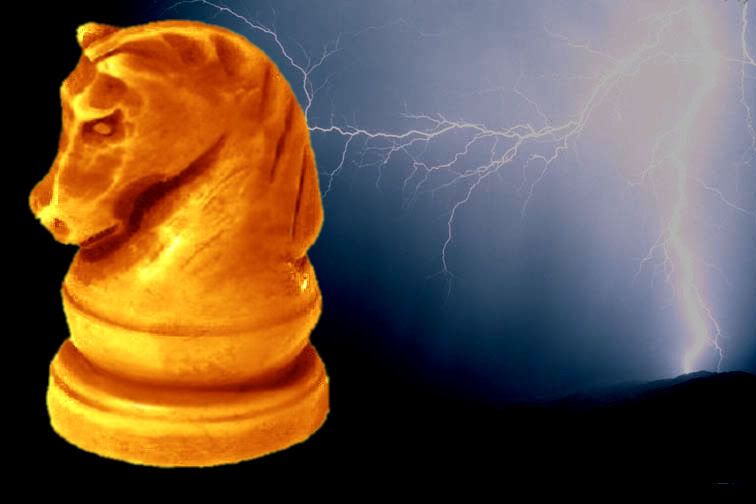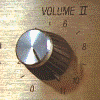Post by JohnH on Oct 25, 2005 7:25:50 GMT -5
It looks like I’m going first on this new board, so here is my design for three single coil pickup switching. I have quite a lot of stuff. I’m hoping others will make much shorter posts!
The ToneMonster2 is named after the thread on which it developed, which started as a simple question about the original Tone Monster on GN. This design uses toggle switches to provide on/off control of each of three single coil pickups, together with an overall series/parallel switch, and a phase switch. The objectives are:
• Consistent switching between series and parallel, ie, if you put pickups in series, and then change to parallel, the same pickups are on
• No dead spots, other than all off (which is a proper quiet ‘kill switch’ setting)
• A blend control, to let you blend continuously from one pickup to the other two, with consistent operation as you change from series to parallel
That last bit, with the blend control, was the hardest to work out, but in use it is very cool. However, the blend can be removed if not wanted.
Diagrams
Here is the schematic:
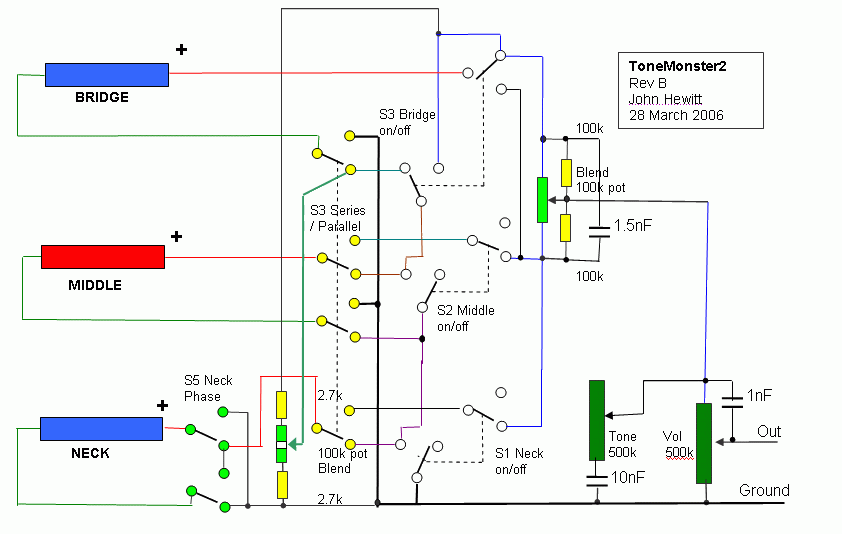
Here is a wiring diagram, as built into a 1980’s Hondo Strat copy
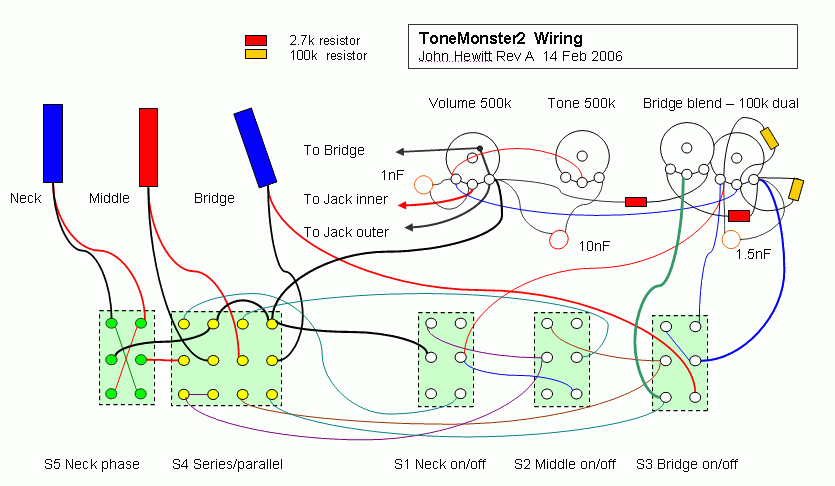
(EDIT - amended 28 March 2006 - improved blender wiring)
On the schematic, you’ll notice on one track of the dual-gang blend pot, a white area. This represents an area at mid position on the track where the carbon is scraped off, to make a no-load zone. This is easy to do, to one wafer of the pot. It allows a fairly low resistance pot to be used for smooth blending, without loading the pickups. The blend is best made with an detented pot, to identify the mid position.
(EDIT: If however, a dual-ganged 100k detented pot is unavailable, use a normal 250k linear dual-gang, with the same scraping to the track. The 250k creates a wider neutral zone around the mid point of the blender travel. Also change the 100k fixed resistors to 39k.)
Photos
Here are some pictures of the finished version:

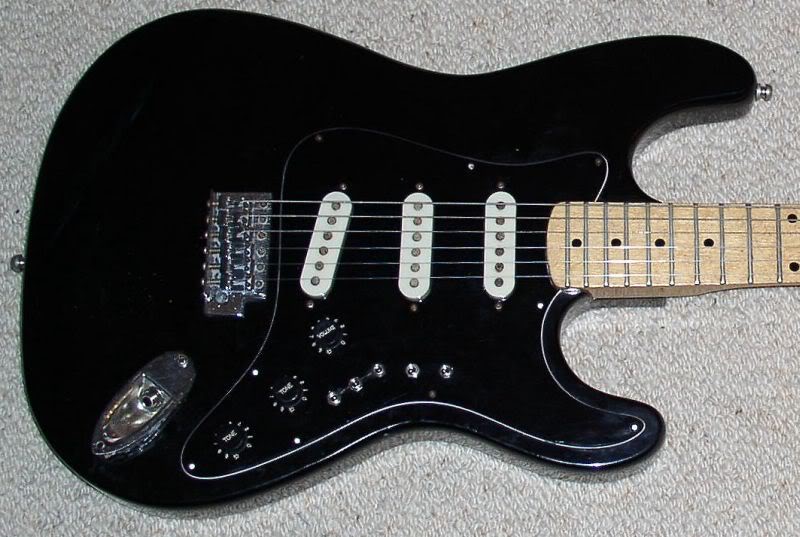
Sound samples
The range of sounds is enormous from ultra bright phased through all the standard Strat noises, to deep humbucker-like series sounds. I believe there are 17 basic sounds, plus blended variations.
The following clips are all directly injected into the computer via an old tape deck as a preamp, with no effects added. The changes are each made by flicking one of the toggles. I hope it is clear from the changes in tone where the transitions happen.
Clip 1 - is as follows:
1. bridge
2. bridge and middle in series
3. bridge, middle and neck in series
4. bridge, middle and neck in series (neck out of phase)
5. bridge and neck in series (neck out of phase)
people.smartchat.net.au/~l_jhewitt/circuits/johnhsss1.mp3
Clip 2:
1. bridge, middle and neck in parallel
2. bridge, middle and neck in series
3. bridge and neck in series
4. bridge and neck in parallel
people.smartchat.net.au/~l_jhewitt/circuits/johnhsss2.mp3
How is this design different?
I believe the blender control, with its operation in both series and parallel is unique. Apart from that, the sounds available are similar to several other designs based on toggle switches with series/parallel. These include the original Tone Monster (different switch operation), Dan Armstrong’s design (use of three position on-on-on toggles) and Wolf’s design (simpler wiring). All of theses are excellent designs. The ToneMonster2, concentrates on ensuring just one consistent function for each switch, with no dead spots – allowing quick and reliable changes.
Options
This design has been built in several versions by Runewalker and myself. Options include whether the blender blends neck or the bridge with the other two, or whether the blender is included at all. The phase switch is shown on the neck, but could also be on the bridge. Tone and volume pot and cap values can be adjusted to taste. It can also be adapted to an HSH design.
So there it is! Please put any questions or comments below, and I will edit this post if necessary with any further info.
John
EDIT 27/10/05
The main parts of the circuit are:
The blender pot has to be linear, to ensure the centre position is an even blend. Also note that the pots sold as blender pots at Stew-Mac etc wont work with this design (they are not linear). The higher the blender pot value, the more the blending action is concentrated to the ends of the travel, although the overall range may be the same.
Scraping of the blend pot track is best done to the rear wafer (it is only needed to one track), after levering up the prongs that retain the back. Here is a picture of me doing it:
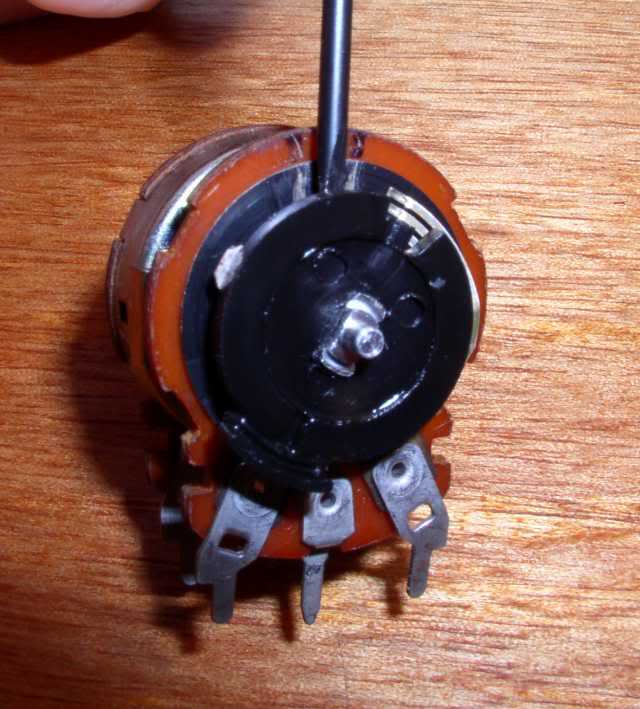
Note that the 100k fixed resistors on the blend pot are very important. They ensure that the loss of signal through the blend pot is not significant enough to be a problem. That is also the function of the bypass capacitor across the blend pot.
EDIT 20/03/08
A final update to the schematic:
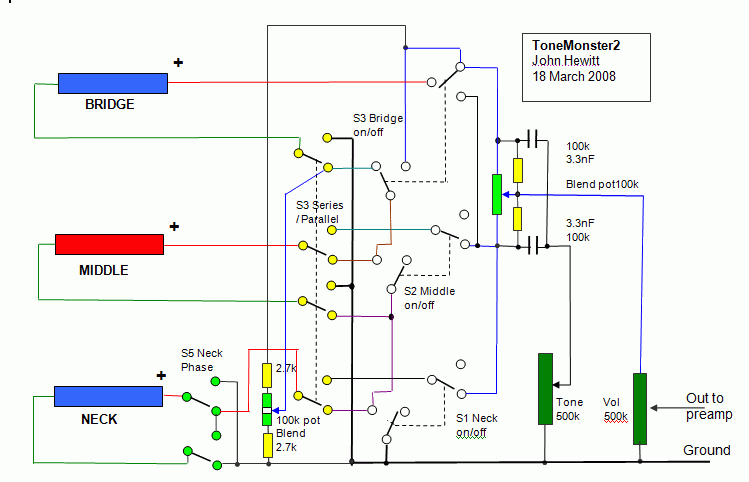
This guitar now has a built-in preamp, based on the Fetzervalve from runnoffgroove.com. I also improved the tone wiring, which as shown above, now gives a very useful sweep in both series ans parallel.
A new sound sample also, using al three in series, first out-of=phase and then in phase:
www.soundclick.com/bands/page_songInfo.cfm?bandID=674084&songID=6383082
regards
John
The ToneMonster2 is named after the thread on which it developed, which started as a simple question about the original Tone Monster on GN. This design uses toggle switches to provide on/off control of each of three single coil pickups, together with an overall series/parallel switch, and a phase switch. The objectives are:
• Consistent switching between series and parallel, ie, if you put pickups in series, and then change to parallel, the same pickups are on
• No dead spots, other than all off (which is a proper quiet ‘kill switch’ setting)
• A blend control, to let you blend continuously from one pickup to the other two, with consistent operation as you change from series to parallel
That last bit, with the blend control, was the hardest to work out, but in use it is very cool. However, the blend can be removed if not wanted.
Diagrams
Here is the schematic:

Here is a wiring diagram, as built into a 1980’s Hondo Strat copy

(EDIT - amended 28 March 2006 - improved blender wiring)
On the schematic, you’ll notice on one track of the dual-gang blend pot, a white area. This represents an area at mid position on the track where the carbon is scraped off, to make a no-load zone. This is easy to do, to one wafer of the pot. It allows a fairly low resistance pot to be used for smooth blending, without loading the pickups. The blend is best made with an detented pot, to identify the mid position.
(EDIT: If however, a dual-ganged 100k detented pot is unavailable, use a normal 250k linear dual-gang, with the same scraping to the track. The 250k creates a wider neutral zone around the mid point of the blender travel. Also change the 100k fixed resistors to 39k.)
Photos
Here are some pictures of the finished version:


Sound samples
The range of sounds is enormous from ultra bright phased through all the standard Strat noises, to deep humbucker-like series sounds. I believe there are 17 basic sounds, plus blended variations.
The following clips are all directly injected into the computer via an old tape deck as a preamp, with no effects added. The changes are each made by flicking one of the toggles. I hope it is clear from the changes in tone where the transitions happen.
Clip 1 - is as follows:
1. bridge
2. bridge and middle in series
3. bridge, middle and neck in series
4. bridge, middle and neck in series (neck out of phase)
5. bridge and neck in series (neck out of phase)
people.smartchat.net.au/~l_jhewitt/circuits/johnhsss1.mp3
Clip 2:
1. bridge, middle and neck in parallel
2. bridge, middle and neck in series
3. bridge and neck in series
4. bridge and neck in parallel
people.smartchat.net.au/~l_jhewitt/circuits/johnhsss2.mp3
How is this design different?
I believe the blender control, with its operation in both series and parallel is unique. Apart from that, the sounds available are similar to several other designs based on toggle switches with series/parallel. These include the original Tone Monster (different switch operation), Dan Armstrong’s design (use of three position on-on-on toggles) and Wolf’s design (simpler wiring). All of theses are excellent designs. The ToneMonster2, concentrates on ensuring just one consistent function for each switch, with no dead spots – allowing quick and reliable changes.
Options
This design has been built in several versions by Runewalker and myself. Options include whether the blender blends neck or the bridge with the other two, or whether the blender is included at all. The phase switch is shown on the neck, but could also be on the bridge. Tone and volume pot and cap values can be adjusted to taste. It can also be adapted to an HSH design.
So there it is! Please put any questions or comments below, and I will edit this post if necessary with any further info.
John
EDIT 27/10/05
The main parts of the circuit are:
- On/off switches for each pup: DPDT mini-toggles (3 needed)
- Phase switch: DPDT mini-toggle (or could be part of a push/pull pot)
- Series/parallel: 4PDT mini-toggle
- Volume and tone pots: 500k audio taper preferred. 1M would also work well.
- Blender pot: 100k Linear, detented, dual gang, with one track scraped at centre position as described)(EDIT - option: 250k linear dual gang non-detented)
- Resistors: 2 x 2.7k, 2 x 100k (or 39k if 250k blender pot used)
- Blender treble bypass capacitor: 1.5nF = 0.0015mfd
- Volume treble bypass capacitor: 1nF – but worth trying lower values, say 470pF
- Tone capacitor: 10nF = 0.01mfd (personal choice, most people use 0.022 or 0.047mfd, but I find a lower value is more appropriate for series wiring)
The blender pot has to be linear, to ensure the centre position is an even blend. Also note that the pots sold as blender pots at Stew-Mac etc wont work with this design (they are not linear). The higher the blender pot value, the more the blending action is concentrated to the ends of the travel, although the overall range may be the same.
Scraping of the blend pot track is best done to the rear wafer (it is only needed to one track), after levering up the prongs that retain the back. Here is a picture of me doing it:

Note that the 100k fixed resistors on the blend pot are very important. They ensure that the loss of signal through the blend pot is not significant enough to be a problem. That is also the function of the bypass capacitor across the blend pot.
EDIT 20/03/08
A final update to the schematic:

This guitar now has a built-in preamp, based on the Fetzervalve from runnoffgroove.com. I also improved the tone wiring, which as shown above, now gives a very useful sweep in both series ans parallel.
A new sound sample also, using al three in series, first out-of=phase and then in phase:
www.soundclick.com/bands/page_songInfo.cfm?bandID=674084&songID=6383082
regards
John





